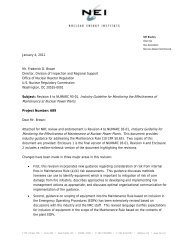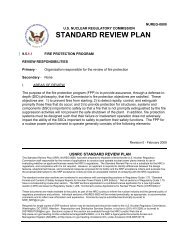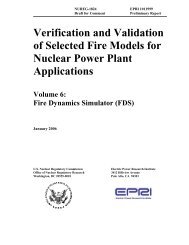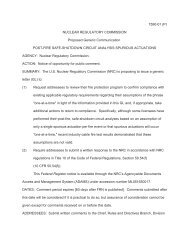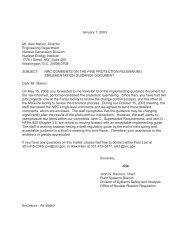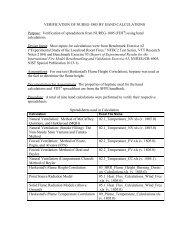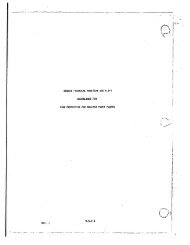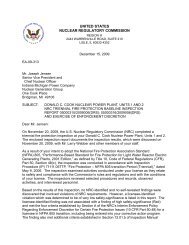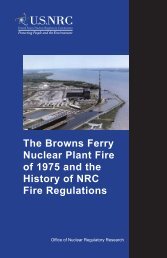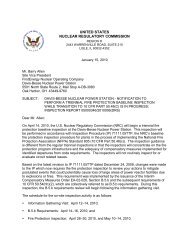NUREG/CR-6850, Volume 1 - NRC
NUREG/CR-6850, Volume 1 - NRC
NUREG/CR-6850, Volume 1 - NRC
Create successful ePaper yourself
Turn your PDF publications into a flip-book with our unique Google optimized e-Paper software.
Conclusions and Closing Remarks• Another perspective gained during the IPEEE program was the relative importance of firescenarios or plant locations with respect to fire risk. For example, 35 studies, or nearly 1 ofevery 3 studies, reported the risk associated with control room fires as the highest contributorto the fire risk. Switchgear rooms came in a close second (21 studies), and turbine buildingthird (12 studies) [3.7, 3.8]. A range of other fire areas were reported as important riskcontributors on a plant-specific basis.It is likely that the relative importance rankings of plant locations will be impacted by the useof this method. When considering any given fire area, risk estimate changes will be drivenmore by plant-specific factors than by generic industry-wide practices. Relatively fewindustry-wide trends are anticipated with respect to changes in the relative risk importancerankings. In some specific cases, such as the main control room, the IPEEE risk estimates aregenerally based on conservative screening analyses rather than detailed analysis. For thesecases, the new methods will likely result in risk estimate reductions. The new methods alsogive rigorous treatment to issues not systematically considered in most IPEEEs (e.g., circuitanalysis issues and post-fire manual actions). As a result, areas with concentrations ofelectrical control cables in particular could see increases in fire risk estimates. The newmethods also give more systematic treatment to fire protection attributes than that appliedin most IPEEE analyses. These attributes include fire protection systems and features,administrative controls of fire hazards, circuit design and separation, post-fire safe shutdownstrategies, and other design and operation related elements influencing fire risk. The additionor enhancement of specific areas of analysis will undoubtedly lead to substantive insightsthat were not available from the previous method. The current method offers more pedigreeand balanced realism (as opposed to unbalanced conservatism) in modeling these attributes.Overlap between these factors leading to changes (e.g., increasing the general level ofanalysis detail and adding consideration of spurious operations) will also lead to offsettingeffects on risk estimates (as noted above).3.5 RecommendationsThe EPRI and RES Technical Development Teams identified a number of areas where furtherimprovements to the state-of-the-art may be beneficial. However, the effort needed to implementthe identified improvements proved beyond the time and resources available to this project.Some of the identified areas of need may present considerable challenges both in technicalknow-how and needed resources.3.5.1 Low Power and Shutdown Operating ModesThe scope of this methodology is limited to fire risk during at-power mode of operation. NFPA805, in particular, requires consideration of non-power modes of operation. A methodology tostudy the risk associated with these other modes would be beneficial to the implementation of arisk-informed fire protection program.3-14





